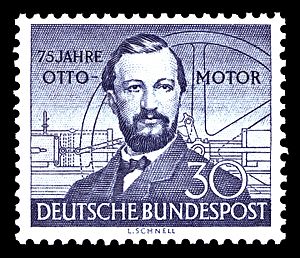Nicolaus Otto facts for kids
Quick facts for kids
Nicolaus August Otto
|
|
|---|---|
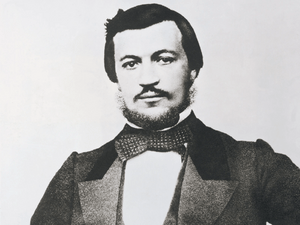
Nicolaus August Otto around 1868
|
|
| Born | 10 June 1832 Holzhausen an der Haide
|
| Died | 26 January 1891 (aged 58) |
| Nationality | German |
| Occupation | Engineer |
| Known for | Internal combustion engine |
| Title | Dr. h.c. |
| Spouse(s) | Anna Gossi |
| Children | e.g. Gustav Otto |
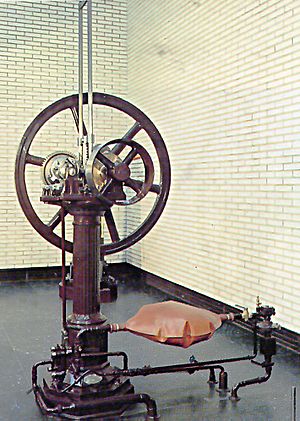
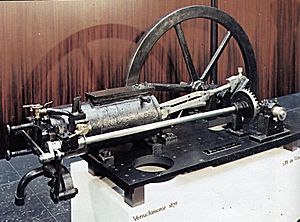
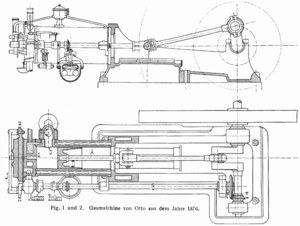
Nicolaus August Otto (born June 10, 1832, died January 26, 1891) was a German engineer. He is famous for developing the modern internal combustion engine. This type of engine uses a special spark to ignite fuel. It is the basis for many engines we use today, including those in cars. The engines that use his design are often called "Otto engines."
Contents
Biography of Nicolaus Otto
Nicolaus August Otto was born in Holzhausen an der Haide, Germany. He was the youngest of six children. His father passed away in the year he was born.
He started school in 1838 and did very well. He later attended a high school in Langenschwalbach until 1848. Although he did not finish his studies, he was known for being a good student.
Otto was very interested in science and technology. However, he first worked as a business apprentice. He then became a salesman, selling items like coffee, tea, and sugar. He traveled across Western Germany for his job.
Early Engine Ideas
In 1860, Otto and his brother learned about a new gas engine. It was built by Jean Joseph Etienne Lenoir in Paris. The brothers tried to build their own version of this engine. They wanted to make it run on liquid fuel.
They applied for a patent in 1861, but their request was turned down. Otto then thought about making an engine that would compress the fuel first. He tried this idea in 1861, but his engine broke quickly. His brother gave up, but Otto kept trying.
From 1862 to 1863, Otto worked with a mechanic named Michael J. Zons. They tried to make the engine better. Otto even took another job to earn money for his experiments.
Partnering with Eugen Langen
In 1864, Otto needed money to continue his research. He met Eugen Langen, whose father was a sugar factory owner. On March 31, 1864, they formed a partnership. Their company was called NA Otto & Cie in Cologne.
This was the first company in the world to focus only on building internal combustion engines. Their first successful engine was an "atmospheric engine." This engine used the explosion of gas to create a vacuum. The power came from air pressure pushing a piston.
This engine used much less gas than other engines of its time. It became a big commercial success. By 1875, the company was making 634 engines each year.
The Four-Stroke Engine
The early atmospheric engine had a problem. It was very tall, needing 10 to 13 feet of space. It also only produced about 3 horsepower. Otto realized this design had reached its limit.
He then went back to his idea of a four-stroke engine. He had failed at this in 1862. With help from engineers Franz Rings and Herman Schumm, Otto finally succeeded. This new engine was called the "Otto Silent Engine."
This engine was the first to successfully compress the fuel inside the cylinder. It appeared in the autumn of 1876 and was an immediate success. The term "Otto cycle" refers to this four-stroke, compressed-charge engine.
Otto married Anna Gossi and they had seven children. His son, Gustav Otto, later became famous for building airplanes.
How the Otto Cycle Works
The Otto engine was first designed to stay in one place. Later, it was adapted for cars. The engine works in four main steps, called "strokes":
- First stroke: The piston moves down, pulling a mixture of fuel (like gas) and air into the engine's chamber. This is the intake stroke.
- Second stroke: The piston moves up, squeezing the fuel and air mixture. This is the compression stroke.
- Third stroke: A spark ignites the compressed mixture. This causes a powerful explosion that pushes the piston down. This is the power stroke.
- Fourth stroke: The piston moves up again, pushing out the burned gases. This is the exhaust stroke.
After these four steps, the cycle starts over.
Earlier Engine Patents
Nicolaus Otto received many patents for his engine inventions. However, there were some challenges with his patents.
His former manager, Gottlieb Daimler, wanted to build smaller engines for vehicles. Otto was not interested in this idea. Daimler left the company and hired a lawyer. The lawyer found an older patent from 1862. This patent, by a French engineer named Beau De Rochas, described the idea of a four-stroke engine.
Because of this older patent, Otto lost one of his key patents. This meant Daimler could sell his engines in Germany without paying royalties to Otto's company. Neither Otto nor Daimler knew about Rochas's patent before this. Rochas himself never built an engine based on his patent.
Other engines, like those by Lenoir, were two-stroke engines. They did not compress the fuel mixture. Lenoir's engines were the first to be mass-produced, with about 700 sold.
Engine Production and Honors
More than 50,000 Otto engines were made in the 17 years after they were introduced.
Otto received many awards for his work:
- His 1864 atmospheric engine won a gold medal at the 1867 World Exhibition in Paris.
- In 1882, he received an honorary doctorate degree from the University of Würzburg.
- His childhood home has been turned into a museum.
- In 1936, a German engineering group decided that "Ottomotor" would be the official term. It applies to all engines that take in fuel, compress it, and ignite it with a special device.
Key Milestones
- 1862: Nicolaus Otto begins his first experiments with four-stroke engines.
- 1864: He establishes the world's first engine factory, NA Otto Cie.
- 1867: His gas engine wins a gold medal at the World Exhibition in Paris.
- 1872: The company moves to a larger facility and changes its name to Deutz Gasmotoren Fabrik.
- 1876: He successfully develops the four-stroke engine, known as the Otto-motor.
- 1882: Production of the older atmospheric engine stops after 2,649 units were made.
- 1884: Nicolaus Otto invents the electric ignition system for engines.
- 1885: Gottlieb Daimler and Carl Benz build the first cars using liquid petroleum engines.
See also
 In Spanish: Nicolaus Otto para niños
In Spanish: Nicolaus Otto para niños


